The last two days of Place de Bordeaux releases have included vintages from three powerhouse producers of different regions, whose commonality lies in their use of Bordeaux varietals. Below we examine these key releases.
Monday 7th September
The second week of September Place de Bordeaux releases began with the latest offerings from cult Californian producer, Opus One. Described by Wine Lister partner critic, Antonio Galloni, as “one of the most complete wines of the vintage”, 2017 Opus One was released onto the UK market at £228 per bottle – the same price as the 2016. Awarding it 95+ points, he states that the 2017 is “a dense, full-throttle beauty”, with “a distinctly red-toned fruit profile that distinguishes it from the surrounding vintages”. Although receiving one point less than the 2016 (which has a score of 96+ from Galloni), the latest vintage holds particular significance. 91% of fruit had been picked just before the devastating Californian wildfires commenced, eradicating two lots of Opus One vines. Awarding 17.5 points to the 2017, Wine Lister partner critic, Jancis Robinson, notes that there is “not a trace of smoke taint”, and describes “a combination of savoury and something as sweet and chalky as Edinburgh rock”.
Both the historic nature of the vintage, and the reduction in volume released this year are facts sure to encourage high levels of interest. Opus One is, perhaps unsurprisingly, the number one US wine (and joint-fifth overall) voted by the trade to have seen the sharpest rise in demand, as shown below:
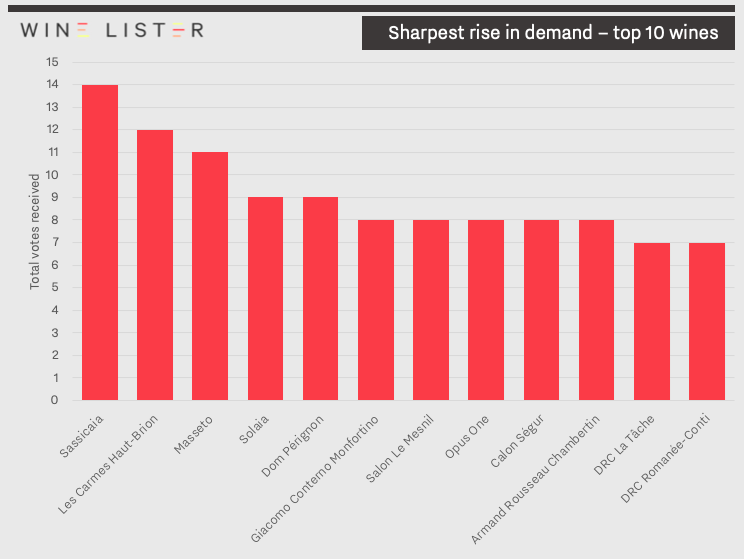 Results from Wine Lister’s 2019 Founding Members survey, showing the consensus on the top 10 wines that have seen the sharpest rise in demand
Results from Wine Lister’s 2019 Founding Members survey, showing the consensus on the top 10 wines that have seen the sharpest rise in demand
Tuesday 8th September
Kicking off yesterday’s releases, Masseto 2017 was released, and merchants were offering at around £480 per bottle. Though slightly higher than last year’s first tranche release price (readers should note that this year, there is only one single tranche), the 2017 enters the market 11% below the current price of the 2016. Antonio Galloni gives the 2017 96-99 points (up from 94-97 for the 2016), calling it a “spectacular wine in the making”, with notes of “red cherry jam, mocha, leather, licorice and a dash of new oak”. While 2017 will be remembered as one of the hottest and driest growing seasons in recent history, Winemaker, Axel Heinz, states that the vintage “managed to encapsulate all the ripeness and concentration” of the climatic conditions. Indeed, Galloni notes that the latest release is “quite simply a remarkable wine for such a challenging year”. Masseto already earns strong acclaim as the wine to have seen the third-sharpest rise in demand according to the trade (see above) – the 15% reduction in volume released onto the market from last year will no doubt only encourage requests for the 2017 further.
The second wine from the cult producer, Massetino 2018 was also released yesterday, at a likely UK market price of c.£205 per bottle. Although its second vintage, this is the first international release of Massetino, as last year’s distribution was limited to the Italian and the US markets only. We sampled the latest release at CVBG’s Beyond Bordeaux tasting, and found it to have expressive, concentrated fruit on the nose, and more refined notes of Marcello cherry and minerality on the palette.
Yesterday’s releases ended with a bang, as Latour released its 2009 vintage. Merchants offering at c.£860 per bottle place the 2009 just under the current market price of the iconic 2010. This is the first ex-château stock to be released since its original en primeur release, and is available at a c.10% premium to existing stock on the market. Wine Lister partner critic, Neal Martin, awards the latest release 99 points, stating that it “is endowed with a simply magnificent nose with intense blackberry and cassis fruit laced with minerals and graphite, extremely focused to the point of overwhelming the sense”. “Wow”, he concludes.
Among other benefits available exclusively to the trade, Wine Lister’s Pro+ Subscription offers real-time release alerts and live analysis on major wine releases throughout the vinous calendar. Please email us at team@wine-lister.com to enquire.
Many wine lovers like us have been making the most of lockdown to explore outside of the more traditional wine-growing regions and grape varieties. Wine Lister’s new cellar analysis service can include tailored guidance on future purchases for drinking or investment, providing recommendations for top-quality wines from alternative producers and regions.
To help you discover some of these brilliant New World picks, the Wine Lister team has put together a short selection of MUST BUYs that have exhibited a recent rise in popularity, as established through search frequency data from Wine-Searcher.
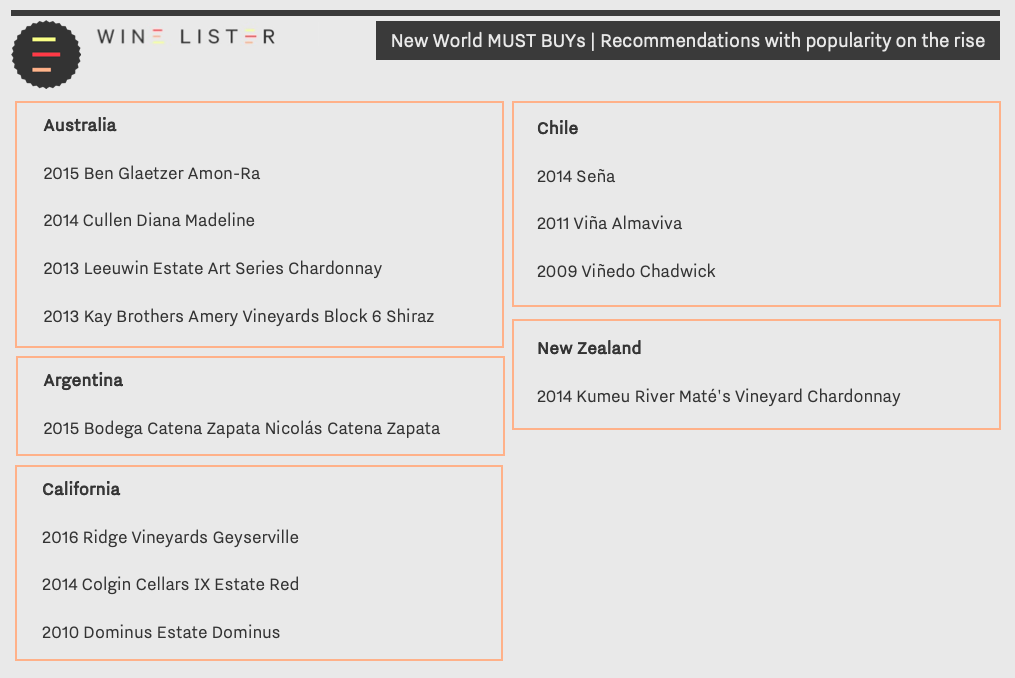
Australia to ask for – 2014 Cullen Diana Madeline
Founded in 1971, the Cullen Estate has maintained concern for its environment since its inception, keeping both chemical intervention and irrigation to a minimum. In 1998, the estate adopted an organic viticulture, which was further developed into a biodynamic practice in 2008. Winemaker, Vanya Cullen, states the biodynamic approach to harnessing Earth’s energy “achieves greater individuality of site through working with nature rather than against it”, suggesting its ability to better display terroir and climate. The estate’s flagship wine, Diana Madeline, comprises a blend of 89% Cabernet Sauvignon with small amounts of Petit Verdot, Merlot, Malbec, and Cabernet Franc in 2014. With a WL score of 95 at £50 per bottle (in-bond), it is described by Wine Lister partner critic, Jancis Robinson, as “refined and elegant”, and displaying “great harmony”. It can be bought by the case of 12 from BI Fine Wine & Spirits.
Argentina to acquire – 2015 Bodega Catena Zapata Nicolás Catena Zapata
Nicolás Catena Zapata helped pioneer the use of European winemaking techniques in Argentina’s high altitudes, following in the footsteps of his grandfather, Nicola Catena – an Italian immigrant who founded the winery in 1902. The inaugural vintage of the namesake wine (1997) was debuted in the USA and Europe at a series of blind tastings, where it received comparison to First Growths Latour and Haut-Brion, and achieved either first or second place in every event. Composed of 83% Cabernet Sauvignon and 17% Malbec in 2015, Nicolás Catena Zapata grapes are fermented in 100% French Oak barrels for 15 days. Fermentation temperatures are kept low, to extract pronounced aromas, while cap management is done by hand to encourage the extraction of nuanced flavours and gentle tannins. The 2015 Nicolás Catena Zapata receives a WL score of 94, at £49 per bottle (in-bond), and can be acquired by the case of 12 from Fine+Rare Wines.
California to call upon – 2010 Dominus Estate Dominus
Owned by Christian Moueix (of Petrus fame), Dominus Estate demonstrates its prestigious proprietorship with one of the highest quality Bordeaux blends in California. Comprised of 95% Cabernet Sauvignon, and 5% Petit Verdot, the 2010 Dominus Estate Dominus was produced in the smallest quantities known to the property since its 1984 vintage – consequential of a rigorous selection of lots for the final blend. Wine Lister partner critic, Antonio Galloni, calls the 2010 “a towering, utterly magnificent wine”, describing “asphalt, licorice, menthol, plums and cassis” that “wrap around the palate and never let up”. With a WL score of 98, at £233 per bottle (in-bond), it can be aged for another 20 years, and is available to purchase by the case of six from Corney & Barrow.
Chile to chase – 2014 Seña
A blend of 60% Cabernet Sauvignon, 16% Carménère, 11% Malbec, 8% Merlot, and 5% Petit Verdot, the 2014 Seña was described by WL partner critic, Jeannie Cho Lee as a “fabulous wine that offers layers of flavors that range from exotic spices, rose petals and violets to blackberries and fresh herbs”. Owner Eduardo Chadwick tells us of his addition of the late-ripening Petit Verdot, which adds spice and complexity to the wine. With extremely fine-grained tannins and acidity, thanks to its cool climate, the wine has received several comparisons with top Bordeaux blends. Achieving a WL score of 96, at £78 per bottle (in-bond), the 2014 Seña can be bought by the case of six from Lay & Wheeler.
New Zealand worth knowing – 2014 Kumeu River Maté’s Vineyard Chardonnay
Achieving a WL score of 94 at £38 per bottle (in-bond), the 2014 Kumeu River Maté’s Vineyard Chardonnay constitutes a good value New World Chardonnay with excellent ageing potential (it can be aged for a further 10 years). Wine Lister partner critic, Neal Martin, describes the 2014 vintage as having “a riveting, brilliantly defined bouquet of oyster shell, citrus peel and apple blossom”, concluding that it is “world-class stuff”. Having taken over the estate from his Dalmatian father, Maté, in 1982, Kumeu River director, Michael Brajkovich, was the first New Zealander to become a Master of Wine, and used his knowledge to develop its viticulture through improving drainage, growing grass between the vines, and introducing a Lyre trellis system. Named after Michael’s late father, the 2014 Kumeu River Maté’s Vineyard Chardonnay is available to purchase by the bottle from Lay & Wheeler.
Also featured in the above MUST BUY recommendations are: 2016 Ridge Vineyards Geyserville, 2015 Ben Glaetzer Amon-Ra, 2014 Colgin Cellars IX Estate Red, 2013 Kay Brothers Amery Vineyards Block 6 Shiraz, 2013 Leeuwin Estate Art Series Chardonnay, 2011 Viña Almaviva, and 2009 Viñedo Chadwick.
For bespoke fine wine purchase recommendations, as well as advice on creating the financial room with re-sale suggestions, get in touch with our team at team@wine-lister.com, or download the full Cellar Analysis information pack.
The global pandemic caused considerable losses to the Champagne industry, with estimations that its sales depleted by more than 75% at the height of lockdown. While we have lacked cause for celebration over the past quarter, parts of the world are now returning to a new normal, with restaurants and bars gradually reopening. It is time to raise a toast to our favourite fizz.
To guide those buying at every level, we have compiled a selection of Champagne MUST BUYs at five different price points.
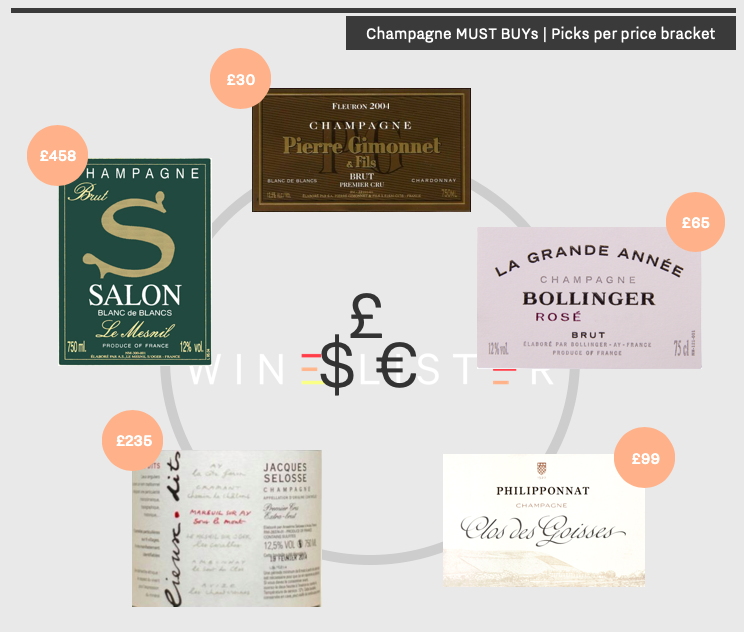
Under £50 – 2009 Pierre Gimonnet et fils Fleuron Brut Blanc de Blancs
Pierre Gimonnet et Fils is an original member of the Club Trésors de Champagne, which, founded in 1971 by 12 longstanding producers, now includes 29 grower Champagne houses that produce, bottle, and age their wine on-site. Currently managed by third-generation vignerons, Didier and Olivier Gimonnet, the property owns 28 hectares of vineyards around the Côte des Blancs. Made from 100% Chardonnay grapes, the estate’s “Fleuron” is produced solely in excellent years, from grapes selected in the best plots of each vineyard. At £30 per bottle (in-bond), the 2009 Pierre Gimonnet et fils Fleuron Brut Blanc de Blancs was described as “absolutely fabulous” by Wine Lister partner critic, Antonio Galloni. A “tropically-leaning expression of fruit marries with the classic Gimonnet emphasis on tension”, Galloni adds. The 2009 is available to purchase in magnum form from Armit Wines.
Under £75 – 2007 Bollinger Grande Année rosé
Added to the estate’s portfolio in 1976, then manager, Lily Bollinger, agreed to the production of a rosé under one condition – it had to be extraordinary. Only made in the best vintages, the 2007 Bollinger Grande Année Rosé comprises a blend of 72% Pinot Noir and 28% Chardonnay, was fermented entirely in barrels, and aged under natural cork. With a WL score of 93 at £65 per bottle (in-bond), it promises impressive ageing potential. Having tasted the 2007 in 2019, Tim Jackson for JancisRobinson.com notes its “chalky texture with red and black cherry, some orange-citrus and plenty of nutty lees”. The 2007 Bollinger Grande Année rosé is available to purchase by the case from Berry Bros & Rudd.
Under £150 – 2004 Philipponnat Clos des Goisses
At £99 per bottle (in-bond), the 2004 Philipponnat Clos des Goisses achieves a WL score of 96. Clos des Goisses is Philipponnat’s flagship cuvée, produced from 65% Pinot Noir and 35% Chardonnay grapes. Grapes are selected from Philipponnat’s walled Mareuil-sur-Ay vineyard, which, at a 45-degree slant, ensures the optimum ripening of Pinot Noir grapes in Champagne’s cool climate. Julia Harding for JancisRobinson.com notes that there is “a toasty richness on the palate, even a slight note of char and chamomile”, calling it a “complex and unfolding wine that cannot be rushed if you want to enjoy its multi-layered character”. The 2004 Philipponnat Clos des Goisses can be purchased by the case from Fine + Rare Wines.
Under £300 – NV Jacques Selosse Blanc de Noirs Le Côte Faron
Founded in 1949, Jacques Selosse is now run by Jacques’s son, Anselme who took over from his father in 1974. Anselme has been praised for instigating a welcomed change in Champagne, encouraging producers to embrace new ideas of low yields, chemical-free vineyards, and terroir-focussed wines. Having implemented a reduction of yields and organic farming within his own production, Jacques Selosse now produces some of the most sought-after wines from the region. Made from 100% Pinot Noir grapes grown in a single vineyard, La Côte Faron in the village of Aÿ, Jacques Selosse’s NV Blanc de Noirs costs £235 per bottle (in-bond). Antonio Galloni names it “a Champagne of total and pure sensuality”, with “tons of textural resonance”. It is available to purchase by the bottle (in-bond) from BI Fine Wines.
Over £400: 2002 Salon Le Mesnil
At £458 per bottle (in-bond), the 2002 from cult Champagne house Salon Le Mesnil was aged for 11 years on lees before being disgorged and released in 2013. Produced only in exceptional years, and as a quality benchmark for pure Chardonnay Champagnes, Salon Le Mesnil’s signature is making Blanc de Blancs with grapes of extremely high acidity, facilitating extended ageing and consequential complexity. The 2002 Salon Le Mesnil earned a rare 19.5 points from Jancis Robinson, who last tasted it in 2019. She describes it as “rich and nuanced on the palate”, featuring “tertiary notes underneath, with some hay and then real grip on the end. Very long with a fascinating narrative”. There appears to be some availability of the 2002 vintage at Goedhuis & Co.
French readers can find this blog in French translation on Le Figaro Vin’s website.
Sign up to Wine Lister’s free subscription to get market insights delivered straight to your inbox.
Despite wide speculation over whether an en primeur campaign could proceed at all in 2020, this year’s campaign is now more or less complete, and Wine Lister’s scores are in. Bordeaux 2019s exhibit high quality across the board, receiving frequent comparison with recent great vintages – 2016, 2015, 2010, and 2009.
Wine Lister has now published its latest Wine Leagues on the new vintage – examining which Bordeaux 2019s rank best for WL score in each major appellation.
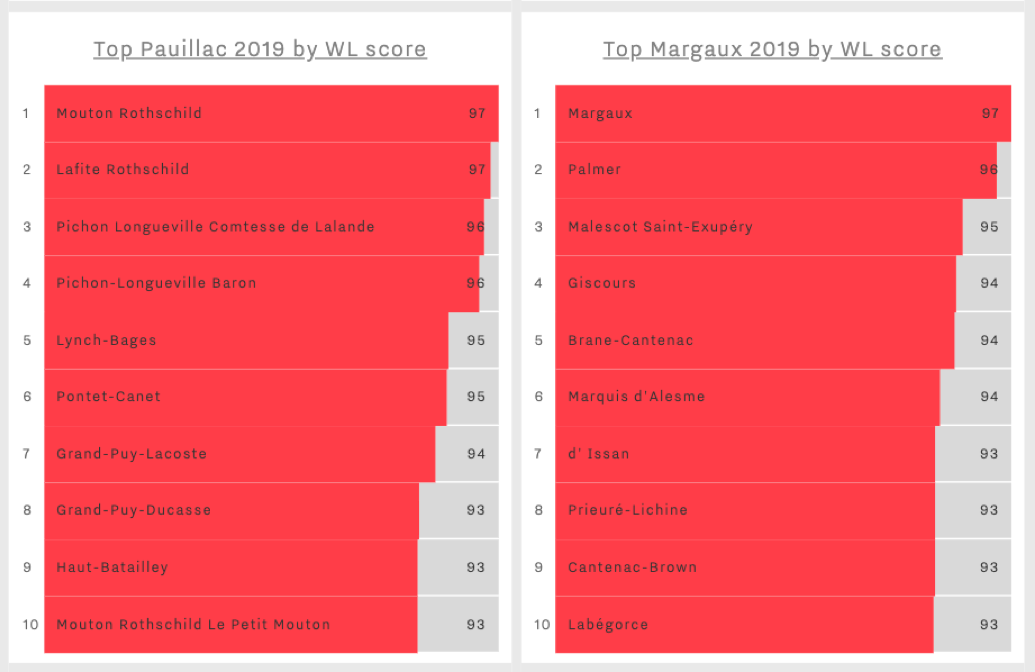
Pauillac First Growths, Lafite and Mouton, lead the appellation’s league of top 2019s by WL score, with a joint score of 97. Pichon Comtesse and Pichon Baron follow suit with 96 – the latter achieving its highest WL score since its 2016 vintage. Wine Lister partner critic Neal Martin describes Pichon-Baron 2019 as having “a very refined bouquet” and a “silky smooth, creamy texture”, stating it “retains all the classicism you could ask for”.
The league of Margaux 2019s by WL score is topped by the appellation’s namesake property, whose latest release joins fellow Pauillac Firsts with a score of 97. Following Palmer’s entry with 96, Malescot Saint-Exupéry 2019 achieves the château’s highest ever WL score (95). Wine Lister partner critic, Antonio Galloni notes that the 2019 is “a striking wine that is sure to find many admirers”, recounting an “interplay of earthy and savoury notes with rich, dense fruit… utterly captivating”.
There are four Value picks featured in the league of Margaux 2019s by WL score, with Labégorce, Malescot Saint-Exupéry, Marquis d’Alesme, and Prieuré-Lichine all achieving scores of 93 and above, at under £35 per bottle (in-bond).
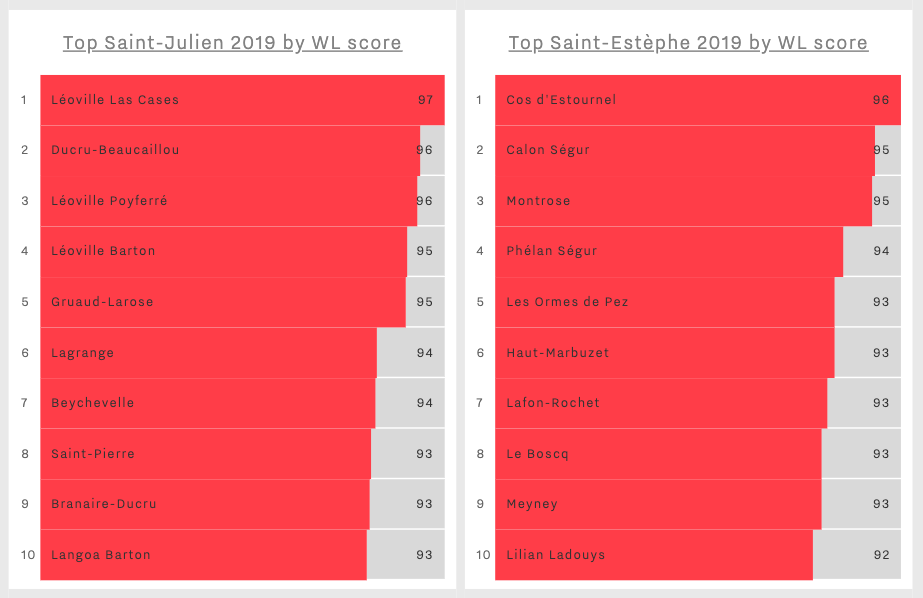
In Saint-Julien, Léoville Las Cases 2019 achieves a WL score of 97, matching that of its 2018 and 2016 vintages. Ducru-Beaucaillou and Léoville Poyferré appear in joint-second place with 96 – achieving their highest WL scores since 2016 and 2015, respectively. Ducru-Beaucaillou 2019 performed notably well at tastings, with Neal Martin, awarding it 96-98 points. He notes its “filigree tannins, pitch perfect acidity and a sensual, satin-like texture”, concluding that the wine is “outstanding in terms of persistence”.
With a score of 96, Cos d’Estournel 2019 tops the league for Saint-Estèphe 2019s by WL score, matching its successful 2018 and 2016 vintages. Writing for JancisRobinson.com, James Lawther describes the vintage as “powerful but carefully constructed and precise”, noting “a lovely mellow quality to such a muscular wine”. While both falling one WL score below their previous vintage, Calon Ségur and Montrose appear second in the appellation’s league, with a shared score of 95.
Branaire-Ducru 2019 and Meyney 2019 exhibit notable value within their appellations – both achieving WL scores of 93 at £29 and £19 per bottle (in-bond), respectively.
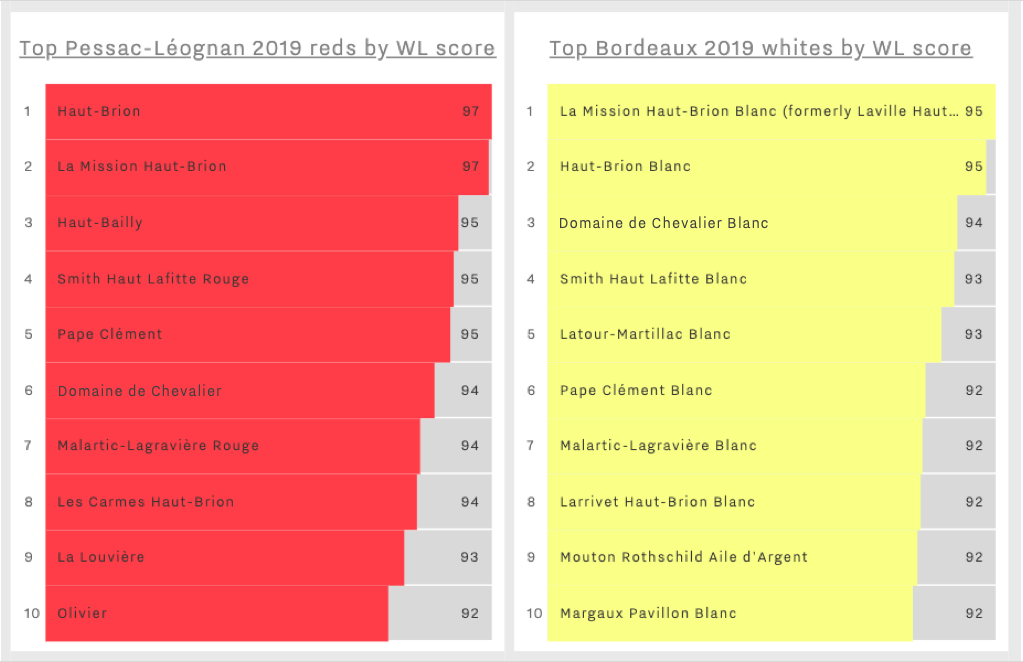
Haut-Brion and La Mission Haut-Brion perform notably well in 2019, achieving joint-first place in the league of top Pessac-Léognan 2019 reds by WL score. As examined in a previous Bordeaux 2019 en primeur blog, the en primeur darling, Les Carmes Haut-Brion, shows clear qualitative success in 2019, and its small production levels and smart en primeur pricing has once again made it a clear campaign buy. Another promising pick from Pessac-Léognan, Olivier 2019 achieves Value pick status at c.£20 per bottle (in-bond), and achieves the château’s highest WL score (92). Antonio Galloni recounts “smoke, licorice, cured meat, graphite and savory herbs infuse the 2019 with striking aromatic intensity to play off its sumptuous fruit”, concluding that the wine is “Very good”.
Haut-Brion and La Mission Haut-Brion attain joint-first place for their whites as well as reds in 2019, achieving scores of 95 in the league of top Bordeaux 2019 whites by WL score. Latour-Martillac Blanc 2019 achieves the highest WL score seen across its vintages (93) – one WL score above Pape Clément Blanc’s 92. At c.£21 per bottle (in bond) Latour-Martillac Blanc 2019 enters the market 10-30% below the current market prices of vintages 2016-2018, showing good value for its quality. Neal Martin notes on the latest vintage: “subtle tropical notes of pineapple and orange rind with hints of strawberry come through on the finish”.
On the right bank, the league of top 10 Saint-Emilion 2019s is crowned by Figeac’s high-scoring 2019. Up one point on its 2018, Figeac’s latest release achieves the highest WL score of all Bordeaux 2019s (98). Figeac 2019 illustrates the château’s impressive upward quality trajectory, which has seen its WL score slowly but surely increase from 91 in 2008. Neal Martin gives the latest vintage 97-99 points, describing it as “exquisitely defined… a deeply impressive, intellectual Figeac”.
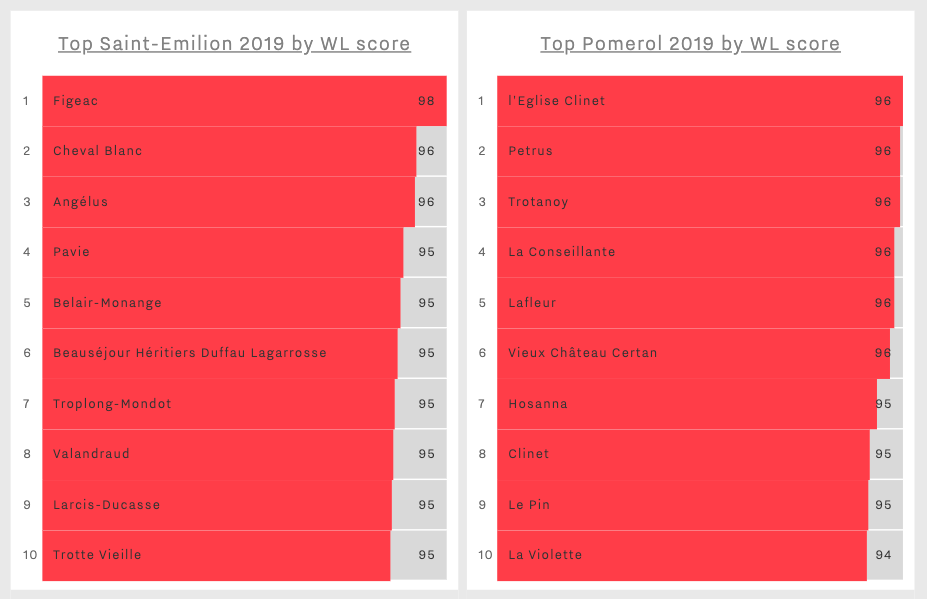
La Conseillante, Lafleur, l’Eglise Clinet, Petrus, Trotanoy, and Vieux Château Certan share the top WL score of Pomerol 2019s (96), separated by mere decimals. A release of note, l’Eglise Clinet 2019 is the last vintage of the late Denis Durantou, who sadly passed away in May. Neal Martin’s impressive score of 97-99 suggests the last vintage was his best, adding, “the perfect way to remember and raise a toast to one of Pomerol’s finest vignerons”.
Click here to view all Wine Leagues. Pro users have access to a more extensive set of Leagues and can log in to access here.
Part I of Wine Lister’s annual in-depth Bordeaux report: For better, for worse, examines the state of the market for Bordeaux wines, in the context of 2019 en primeur.
As well as providing insight into the wine trade’s latest position on key wines of the region, the study examines Bordeaux’s disconnect between consumer popularity and its market performance at the start of 2020 (exacerbated by recent macro-economic hits to the UK, Hong Kong, and the US).
As illustrated below, Bordeaux has achieved the slowest price growth on the secondary market since May 2014, while Piedmont has seen the most impressive growth – likely due to increasing attention given to the region, and the rarity factor of many of its top wines, from which Burgundy also benefits.
 The price performance of Bordeaux compared to four other key fine wine regions: Burgundy, California, Piedmont, and Tuscany. The price indices comprise the top five wine brands in each respective region.
The price performance of Bordeaux compared to four other key fine wine regions: Burgundy, California, Piedmont, and Tuscany. The price indices comprise the top five wine brands in each respective region.
A glance at its price performance since May 2019 tells a similar, if more unnerving story – Bordeaux has floundered over the past year, down nearly 5%.
Despite its price performance difficulties, Bordeaux nonetheless continues its legacy as the most popular wine region by a large margin, based on monthly searches made on Wine-Searcher.
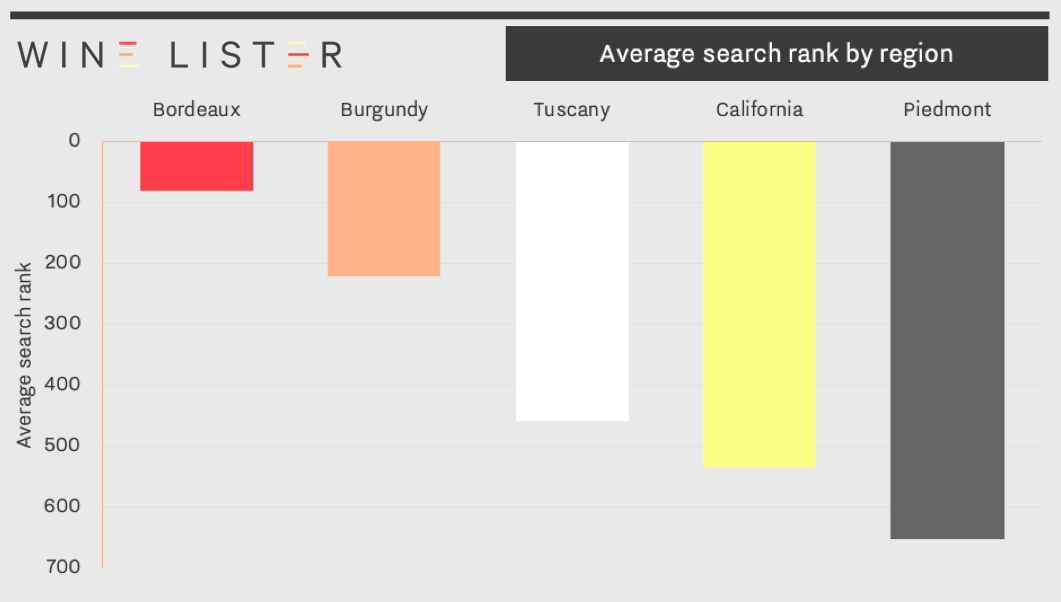 The average search rank of Bordeaux compared to four other key fine wine regions: Burgundy, California, Piedmont, and Tuscany. Results are based on the average searches on Wine-Searcher for the 50 top-scoring wines per region over the last year.
The average search rank of Bordeaux compared to four other key fine wine regions: Burgundy, California, Piedmont, and Tuscany. Results are based on the average searches on Wine-Searcher for the 50 top-scoring wines per region over the last year.
Irrespective of its price performance struggles, Bordeaux remains a focus of fine wine buyers – within the trade and beyond – all over the world. The en primeur campaign is a wheel that just keeps on turning, even in spite of a global pandemic. Trade and consumers alike can’t help but back Bordeaux, for richer and poorer.
More insight into the success of the 2019 en primeur campaign will be included in Part II of this study. In the meantime, visit the Analysis page to purchase Part I, or download using your Pro subscription (available in both English and French).
Today is the 12th working day since the first major 2019 en primeur release, and over 60 wines are already out.
Among others, the last couple of days have seen the 2019 release of another first growth, a Pauillac powerhouse brand, and a major up-and-comer.
Haut-Brion released its red and white grands vins yesterday, at £295 and £560 per bottle in-bond respectively. While the red enters the market a solid 25% below the current market price of the 2018, the white is the campaign’s most expensive wine yet, and offers a smaller discount, of 5% on 2018.
Following Mouton Rothschild’s lead, Haut-Brion’s red looks well-priced within the current economic context, though buyers may note that the 2014 is available on the market around the same price. The 2012 also looks good – earning a WL score of 96, it is a Wine Lister MUST BUY (and available for c.£260 per bottle in-bond).
Also released from the Clarence Dillon family are Haut-Brion’s baby brother, Le Clarence (at c.£100 per bottle in-bond), and cousins La Mission Haut-Brion red and white. Of the two flagship reds, Haut-Brion is likely the stronger horse to back, based on its first growth status, as well as its position according to the trade among top Bordeaux wines for future prestige (see below).
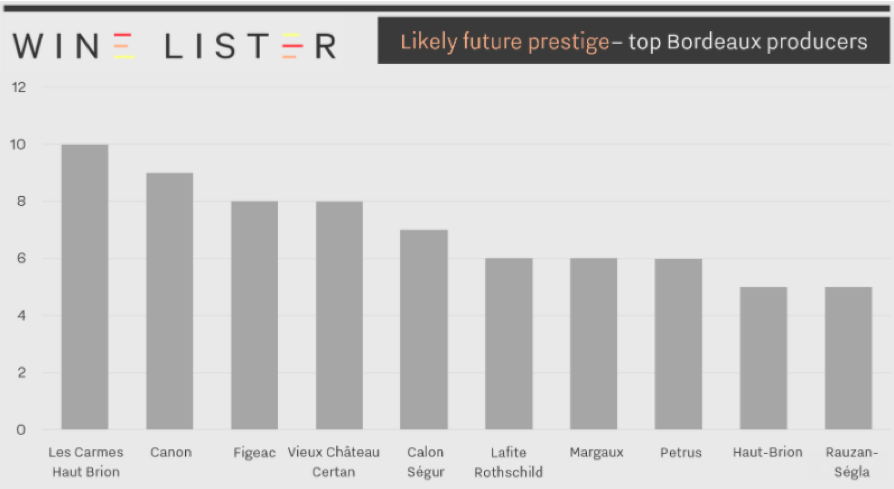 According to Wine Lister’s 2020 trade survey, Haut-Brion is one of top Bordeaux wines most likely to be worth including in collectors’ future cellars.
According to Wine Lister’s 2020 trade survey, Haut-Brion is one of top Bordeaux wines most likely to be worth including in collectors’ future cellars.
Three further pairs of releases from Pessac-Léognan have emerged over the last two days, comprising Malartic-Lagravière, Latour-Martillac, and Carbonnieux.
On Thursday 10th June, Pauillac star-brand Lynch Bages was released, and has resulted in an onward UK selling price of c.£66 per bottle in-bond. Wine Lister’s CEO, Ella Lister, tasted it last week, and found it to be “lifted, precise”, and “a classic”. The price positioning under £70 has reportedly been well-received.
Haut-Batailley was also introduced to the market, at £36 per bottle in-bond. As its second en primeur release under Cazes ownership (the same family as Lynch Bages), the 2019 is 20% under the current market price of the 2018. Following a repositioning of Haut-Batailley’s pricing during en primeur last year, the 2019 release looks good value – the wine’s strong reputation will likely only become stronger with a new wave of investment, and prices are likely to rise accordingly. Lister describes Haut-Batailley 2019 as “pretty”, “elegant”, and “very harmonious”, with a “long, saline, dark chocolate finish” – this is a wine to buy now.
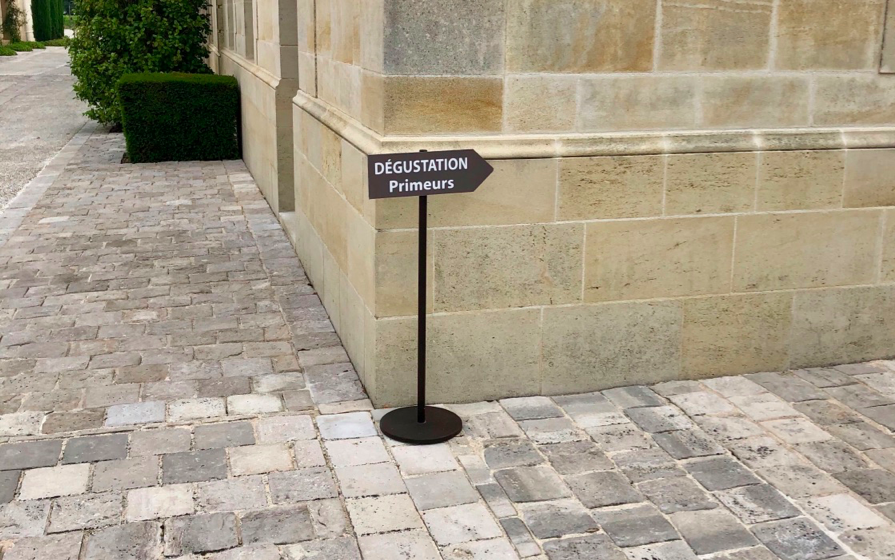 Better late than never – Wine Lister’s CEO, Ella Lister, has now tasted the majority of Bordeaux 2019s. Watch this space for her favourites, and Bordeaux 2019 MUST BUYs coming soon.
Better late than never – Wine Lister’s CEO, Ella Lister, has now tasted the majority of Bordeaux 2019s. Watch this space for her favourites, and Bordeaux 2019 MUST BUYs coming soon.
One further release for each side of the river caught Wine Lister’s eye this week: La Gaffelière 2019 was released 13% beneath the current 2018 market price. The château’s director, Thomas Soubes, told Wine Lister that he was very happy with the quality of their 2019, and Lister concurs – she finds the wine “serious” and “charming”, with “velvet tannin” and “seductive red fruit”. La Gaffelière continues to present excellent value for its impressive quality, relative to wines sharing the Saint-Emilion Grand Cru Classé “B” classification.
Calon Ségur 2019 was also released yesterday. As one of the top rising stars of Bordeaux, its 2019 came onto the market 10% below the 2018 release price, but crucially 31% below 2018’s current market price. Calon Ségur is one of the “poster children” for the true benefits of buying en primeur. Lister found Calon Ségur 2019 to be “perfumed”, “juicy”, and “unctuous”, with “spice on the mid-palate” and a “saline, super-precise finish”. As ever, this is worth snapping up before its price inevitably increases post en primeur release.
Also released during the same period were: Cantenac-Brown, Capbern, Clos Fourtet, Clos René, Cos Labory, Kirwan, Monbousquet, Moulin Saint-Georges, Pavie, Phélan Ségur, Pibran, and Suduiraut.
Keep up to date with further Bordeaux 2019 en primeur releases through Wine Lister’s dedicated en primeur page.
Now into its second full week, the Bordeaux 2019 en primeur campaign shifted up another gear today, with the release of first growth Mouton Rothschild, and its associated properties.
After the flurry of releases yesterday (Monday 8th June) met with very mixed reviews, Mouton reset the campaign tone, with a price 30% below the current market price of 2018, and under the price of all recent back vintages. Bordeaux buyers no doubt breathed a sigh of relief at the tidy figure – £299 per bottle in-bond – the most obvious buy of the campaign so far (other than Lafleur).
Not only is this release on the money in recognising today’s difficult economic context, as well as Bordeaux’s recent price performance struggles, it also provides a brilliant deal given the reported quality of 2019. Wine Lister’s Founder and CEO, Ella Lister found Mouton 2019 to be floral, elegant, and stately. With a high proportion of Cabernet Sauvignon (90%, vs. an average 83%) it promises a long, prosperous life ahead.
Mouton’s younger sibling, also released this morning, looks equally appealing, if for different reasons. Petit Mouton is one of Bordeaux’s top wines for long-term price performance, and its 2019 release price thus manages to enter the market well under all recent back vintages.
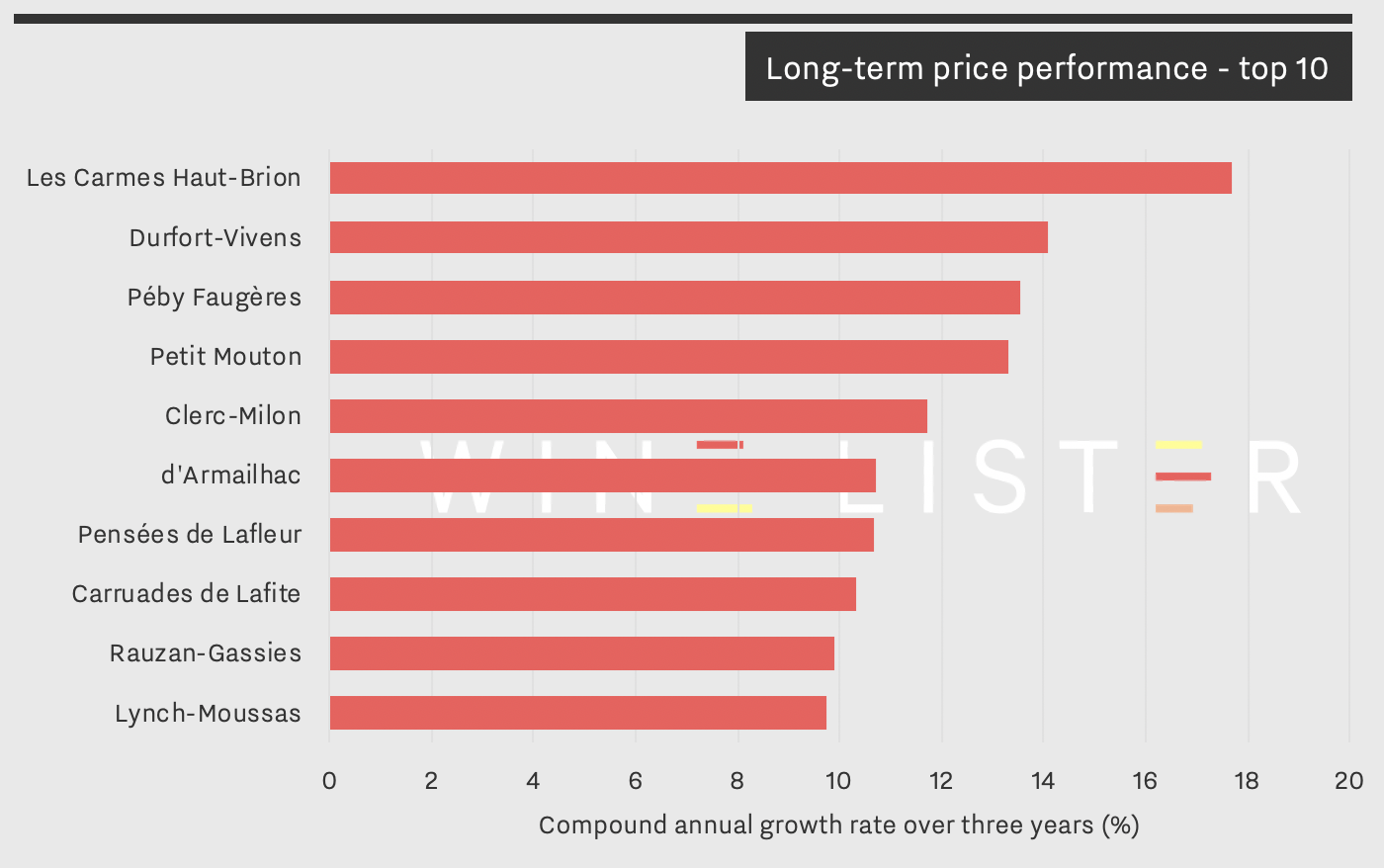 Of major Bordeaux brands, Petit Mouton achieves an average three-year CAGR (compound annual growth rate) of 13.3%, placing it in fourth place of the top 10 long-term price performers, as shown above.
Of major Bordeaux brands, Petit Mouton achieves an average three-year CAGR (compound annual growth rate) of 13.3%, placing it in fourth place of the top 10 long-term price performers, as shown above.
The other 2019s in the Mouton stable, d’Armailhac, Clerc-Milon, and Aile d’Argent were also released today, at prices (per bottle, in-bond) of £31, £52, and £60 respectively.
Yesterday’s hot ticket was right-bank royalty, Cheval Blanc, whose release at £375 also offered consumers a substantial discount on the 2018 release price (32%). Though not yet scored widely by critics, using 2018 as a proxy would mean Cheval Blanc 2019 achieves its joint-highest WL score since the 1961 (alongside the likes of recent greats – 2016, 2015, 2010, 2009, and 2005).
Fellow Saint-Émilion Grand Cru Classé A, Angélus, also released yesterday, though its release price in line with the physically available 2015 perhaps makes it look less attractive. There is nonetheless a real step-change in style and quality happening at Angélus, pioneered by the de Bouärd father-daughter team (Hubert and Stéphanie), which could mean this release is worth investing in for the future.
Two further releases of note from yesterday both hail from Saint-Julien. Branaire-Ducru, a Wine Lister favourite, released its 2019 at £29 per bottle in-bond, 25% down on the 2018 release price. Assuming Branaire’s 2019 is on par with 2018 quality, this is an absolute buy, as the estate’s joint best-ever grand vin at a price beneath all other recent vintages on the market. Léoville-Poyferré 2019 was also released, at £51.34 per bottle in-bond. Offering a 25% discount on last year’s release price for the same quality level, the Saint-Julien second growth is worth considering – having tasted it last week, Lister notes that it is “super-fresh, scented, and luscious”.
Also released so far this week are: Beychevelle, Carillon d’Angélus, Coutet, Gazin, Haut-Bages Libéral, Ferrière, La Gurgue, La Tour Carnet, Larrivet Haut-Brion red and white, and Petit Cheval.
As shown in a recent post on using Wine Lister to build your portfolio, Burgundy is the best-represented region of Wine Lister’s MUST BUY hoard (33%, or 533 wines). 10% of these (161 wines) are white Burgundies, that show high quality and good value within their respective vintages and appellations. These wines cover a vast range of prices, from £15 (per bottle in-bond) up to £1,354.
This week’s blog post examines white Burgundy MUST BUYs at five different price points, to help the hunt of those buying fine wine at every level.
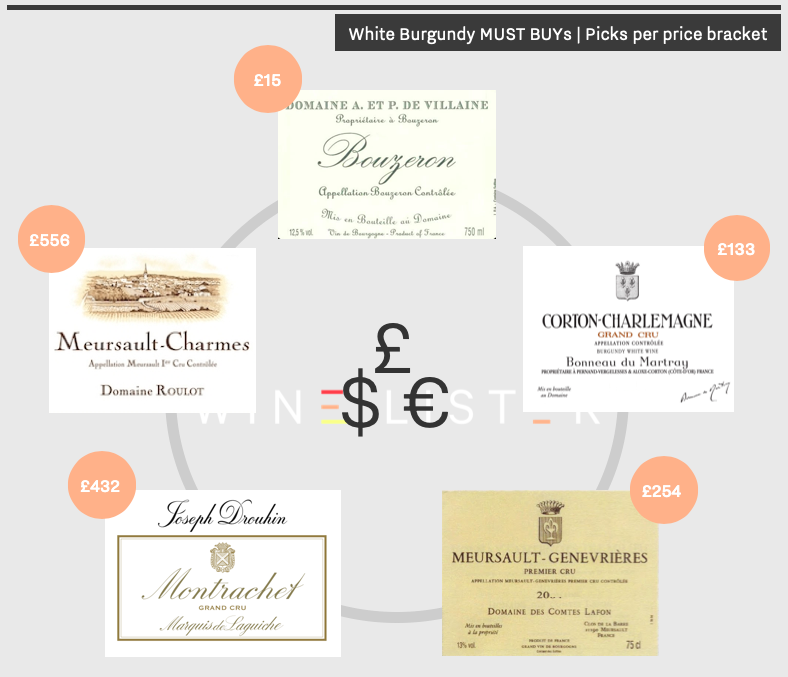 Prices are shown per bottle in-bond (when buying by the case).
Prices are shown per bottle in-bond (when buying by the case).
Under £20 – 2016 Domaine A. & P. de Villaine Bouzeron
Bouzeron’s location in the north of the Côte Chalonnaise provides the setting for Aubert de Villaine’s personal project – one with a humbler reputation than that of his magnum opus, Domaine de la Romanée-Conti. Dispelling the region’s once-unfavourable reputation, de Villaine’s restricted yields and hand-harvesting produces top quality Aligoté Doré. The 2016 vintage achieves a WL Score of 90, and was described by Neal Martin as having “a touch of salinity towards the finish with judicious hints of stem ginger and a hint of rhubarb”. This wine is available to purchase from Justerini & Brooks, where a case of six starts at £90 (in-bond).
Under £150 – 2015 Domaine Bonneau du Martray Corton-Charlemagne
Bonneau du Martray is the largest single owner of vines in Corton-Charlemagne – an appellation that is often said to rival Montrachet. The 2015 vintage was discussed in Wine Lister’s blog on the top 2015 white Burgundies by WL score, in which it was the second highest overall scorer. As of 2018, around 25% of Bonneau du Martray’s Corton-Charlemagne vineyards has been leased to Romanée-Conti – a factor that could drive its price up in the future. For now, this Corton-Charlemagne remains of exceedingly good value in the context of Grand Cru white Burgundy. The 2015 vintage can be purchased from UK merchants such as Goedhuis, where a case of six costs £916 (in-bond).
Under £350 – 2012 Domaine des Comtes Lafon Meursault Genevrières
Despite lacking the Grand Cru status held by Corton-Charlemagne, the higher cost of Domaine des Comtes Lafon’s Meursault Genevrières (Premier Cru) could in part be reflective of the increasing popularity of Meursault. Dominique Lafon is often considered one of the leading producers in Meursault, as reflected in his meticulous vinification process. Spending two winters in wood, and sleeping in some of the deepest and coldest cellars in the region, his wines are bottled nearly two years after harvest – one of the latest bottlings in Burgundy. Achieving a WL score of 94 and ‘Investment Staple’ status, the 2012 vintage is available to purchase from Four Walls Wine Co., where a bottle costs £225 (in-bond).
Under £500 – 2017 Maison Joseph Drouhin Montrachet Marquis de Laguiche
The second Grand Cru white Burgundy examined here is more expensive than Bonneau du Martray’s Corton-Charlemagne, but nonetheless also good value – this time in the context of Montrachet specifically. Hailing from négociant house Joseph Drouhin, its Montrachet Marquis de Laguiche is priced around £432, while the average price of all Montrachet 2017s on Wine Lister is £1,249. Sourcing grapes from vineyards owned by the Laguiche family, the quality here is just as impressive as several Montrachet wines produced by Burgundy domains. Achieving a WL score of 95, the 2017 vintage was described by Jancis Robinson as “Creamy, deep, powerful and endlessly long”. This wine is available to purchase from Berry Bros. & Rudd, where a case of six bottles starts at £2,750 (in-bond).
Over £500 – 2015 Domaine Roulot Meursault Charmes
The “blowout” wine of this week’s selection is Domaine Roulot’s Meursault Charmes. Having assumed direction of the estate in 1989, Jean-Marc Roulot has been successful in fine-tuning the distinct style of wine developed by his father, Guy Roulot. While many other wines of this village exhibit richness and concentration, the 2015 Meursault Charmes reflects Jean-Marc’s commitment to achieving a brighter style of Meursault – one which expresses its terroir vividly. Speaking on his aversion to excessive lees-stirring, he says, “I prefer to lose a little volume and power on the palate in order to obtain the ‘ligne droite’ [straight line] and the purity. This haunting purity and directness is evident in every wine Roulot produces.” The wine is available from several UK merchants, including Morgan Classic Wines, and Fine+Rare, from which prices start from £425 (per bottle in-bond).
Wine Lister has a new toy.
From our user research over the three years since Wine Lister’s inception, it is clear that, even in the purchase of ultra high-end wines, wine buyers enjoy getting “maximum value”. Whether a bottle of wine costs £50, or £5,000, there is satisfaction in knowing that you have purchased “a good buy” – that the quality of your bottle relative to where (or when) it is from, and how much it costs, is worth every penny you spent.
Enter WL MUST BUY, Wine Lister’s new buy recommendation tool – a data-driven algorithm overlaid with human intelligence, and the answer(s) to this very question.
Wine Lister’s proprietary MUST BUY algorithm picks out wines of a predefined, minimum quality level presenting value within their respective vintages and appellations, and overlays the latest industry intelligence from key players in the global fine wine trade. The Wine Lister team then scours the results to identify must-buy wines based on our own tasting experience and market knowledge. This final list is dynamic, constantly changing as new data comes in and when the team reports back from our frequent travels and tastings.
There are currently just over 1,800 MUST BUYs out of the 30,000 + wine-vintages on Wine Lister. See the chart below for a breakdown of MUST BUYs by region.
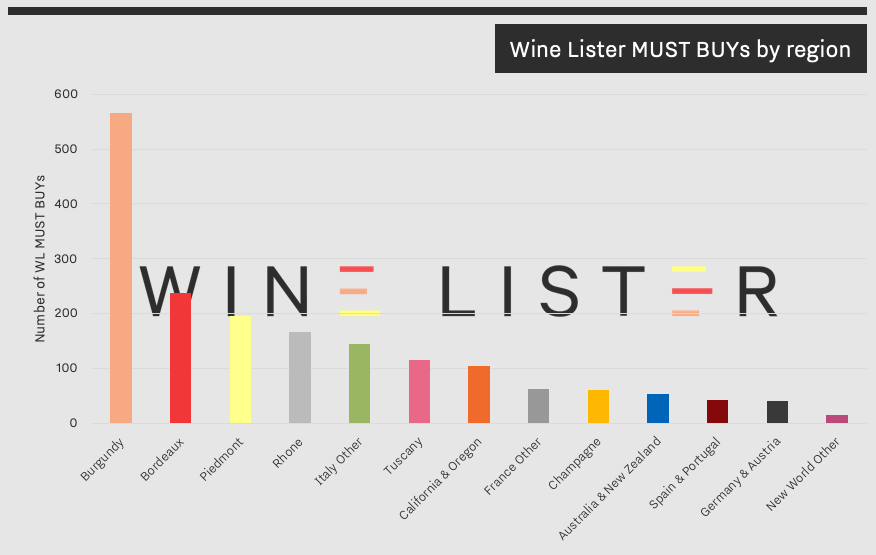
Perhaps unsurprisingly, Burgundy dominates the MUST BUY list, with more than double the number of MUST BUYs of any other region, taking up 31% of the complete list. Burgundian MUST BUYs range from the well-known, such as Comte Liger-Belair’s La Romanée (2007, 2012, 2013, 2014), or Marquis d’Angerville’s Clos des Ducs (2012, 2015, 2016), through to Hidden Gems such as Stéphane Magnien’s Clos Saint-Denis (2010, 2016), or David Duband’s Clos de la Roche (2013, 2014).
Bordeaux follows, encompassing a wide range from five vintages of Petrus down to two vintages of Château Marsau.
Piedmont, the Rhône and other Italian wines (from the likes of Campania, or Veneto for example) come closely behind in third, fourth, and fifth places. New world MUST BUYs are led by the USA, with 99 wines from California, and six from Oregon, while sparkling wines are represented exclusively by the 60 Champagnes to make the cut.
As well as a wide variety of regions covered, the MUST BUY list spans a huge range of prices – see MUST BUYs by price bracket in the chart below.
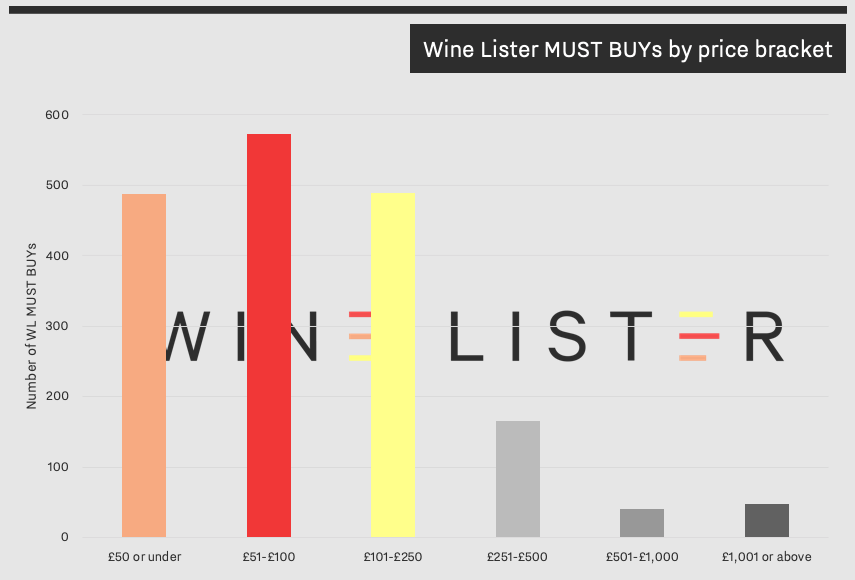
Though pricing is taken into account within the algorithm, the element of relativity means that high-priced wines are not necessarily disqualified. The most expensive MUST BUY wine is 2006 Romanée Conti, from the wine’s namesake Domaine, at £14,853 per bottle in-bond. The least expensive, is 2011 Condado de Haza, at £9 per bottle in-bond.
At the end of this year’s Bordeaux en primeur campaign we released our 24 Bordeaux 2018 MUST BUYs – revisit the blog on these here.
Over the coming weeks we will be releasing commentary on top MUST BUYs by segment (region, appellation, colour, price). In the meantime the full list is available for exploration and discovery here. Play to your heart’s content (MUST BUYs are accessible to all on Wine Lister’s new, free site).
Chloe Ashton
September 17, 2019
Opus One has released a small library parcel of their 2012 this morning at €265 ex-négociant. The factsheet below summarises its key points.

You can download this factsheet here: Wine Lister Factsheet Opus One 2012
Jason Tamblin
February 5, 2019
 Results from Wine Lister’s 2019 Founding Members survey, showing the consensus on the top 10 wines that have seen the sharpest rise in demand
Results from Wine Lister’s 2019 Founding Members survey, showing the consensus on the top 10 wines that have seen the sharpest rise in demand









 Of major Bordeaux brands, Petit Mouton achieves an average three-year CAGR (compound annual growth rate) of 13.3%, placing it in fourth place of the top 10 long-term price performers, as shown above.
Of major Bordeaux brands, Petit Mouton achieves an average three-year CAGR (compound annual growth rate) of 13.3%, placing it in fourth place of the top 10 long-term price performers, as shown above.


